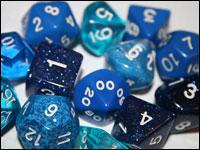Transcript
BOB GARFIELD:
Dungeons & Dragons co-creator Gary Gygax died this week. The fantasy role-playing game known simply as D&D was first released in 1974 and is still being played today in a completely new gaming and social networking landscape that it helped to shape.
Over the years, it’s been accused of inspiring psychosis and witchcraft as well as being the pastime of geeks. I’m talking true nerds, and Time Magazine columnist and admitted D&D player James Poniewozik makes no bones about that.
JAMES PONIEWOZIK:
It was fair when I played it. It was certainly fair of me [LAUGHS] at the time, but it’s probably not fair to say that any more. Role-playing games are things that popular and unpopular kids play now. It’s sort of, you know, the dominant mode of the culture.
You know, as we know from the whole dotcom boom, from the success of Bill Gates from, you know – all these different factors, there’s kind of a pride in dorkiness that certainly didn’t exist back when, you know, I was rolling my 20-sided dice when I was 12 years old.
BOB GARFIELD:
When you played D&D, what was your name and what species were you?
JAMES PONIEWOZIK:
I had a bunch of different characters, but the one I remember that I had for a long time was Giles the Paladin. He was sort of like a magical religious fighter.
BOB GARFIELD:
And how did you prosper in the game? I mean, are there winners and losers?
JAMES PONIEWOZIK:
You don’t win or lose the game, but you can get killed or not get killed. Like in, you know, a lot of video games, you don’t really prosper by quote unquote winning or losing games, but by advancing your characters so that they get more experience and more abilities and more treasure and just stuff.
Oh, I remember my weapons, too. I had a magical halberd.
BOB GARFIELD:
You had a who?
JAMES PONIEWOZIK:
A halberd is a kind of long pole-ax with a pointy thing at the end of it. You learn a tremendous amount about medieval weaponry playing D&D.
BOB GARFIELD:
What about women? They don’t seem to haunt Dungeons & Dragons, or these other modern role-playing games. Is that my imagination or is this substantially a guy thing?
JAMES PONIEWOZIK:
Again, I think back when I played it, it was much more a guy thing. You know, I knew a few girl D&Ders but it was something that was definitely geared more toward a male kind of escapism.
And just as it’s not as exclusively dorky as it used to be, I also think it’s not as exclusively male. You know, I do think that the whole culture of gaming and the descendants of D&D are a little more broadly women-friendly than they used to be.
BOB GARFIELD:
One thing I remember is a bunch of stories about Dungeons and Dragons fantasies going too far and parents terrified and outraged about what their children were doing. Does it have some sort of darkness to its legacy?
JAMES PONIEWOZIK:
Dungeons & Dragons was one of the antecedents of a lot of the cultural bogeymen that we see nowadays. And much like later on we learned that Marilyn Manson or rap music or violent video games would do horrible things to you, back then Dungeons & Dragons was supposedly this satanic, obsessive, addictive game that would make you go crazy and make you a permanent bachelor.
BOB GARFIELD:
[LAUGHS] So let’s talk about the effect Dungeons & Dragons had on today’s fantasy role-playing games.
JAMES PONIEWOZIK:
Well, one of the most popular role-playing video games nowadays is World of Warcraft, which is sort of a networked social analog to Dungeons & Dragons, in which, likewise, you play characters and acquire weapons and acquire treasure and so forth.
Even in a broader sense, a lot of games that are played nowadays involve some kind of social aspect or imaginative role-playing aspect, even, you know, non-violent, non-fantasy games like, say, The Sims.
What Dungeons & Dragons and its associates spawned was this whole idea that games were kind of more fun when they were open-ended and you could play roles and interact with other people.
BOB GARFIELD:
Now in addition to games, the D&D culture has also seeped into more mainstream content like TV shows. Tell me which shows you think are direct beneficiaries of the culture that Gary Gygax cultivated.
JAMES PONIEWOZIK:
Case one on TV nowadays has to be Lost, whose producers have said that they themselves have been very influenced by video games and role-playing games. And to use, you know, one of those useful SAT analogies, Lost is to a show like The Fugitive what D&D was to a game like Monopoly, which is to say that this whole trend in popular culture nowadays, which spawned largely from D&D and things like that, is that interactivity and sprawling narrative and the ability to go down rabbit holes and digress and so on is just much more appealing now than stories and games that are strictly linear, sort of you know, handed down to you top down.
You know, the experience of watching Lost on TV and then immersing yourself in the culture of Lost through the associated games and websites and so on is very much like the immersive experience of playing D&D as opposed to just, you know, opening a game in a box and playing it for, you know, an hour on a rainy afternoon.
BOB GARFIELD:
All anticipated by Gary Gygax, you know, by three decades. That sounds to me like the ultimate case of Revenge of the Nerds.
JAMES PONIEWOZIK:
Absolutely, and that is the story of our lives.
BOB GARFIELD:
James, as always, thank you very much.
JAMES PONIEWOZIK:
Oh sure, thank you.
BOB GARFIELD:
James Poniewozik writes Time magazine’s “Tuned In” column. Gary Gygax, co-creator of Dungeons & Dragons, died this week at age 69.

